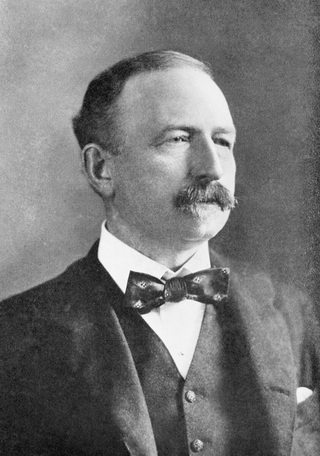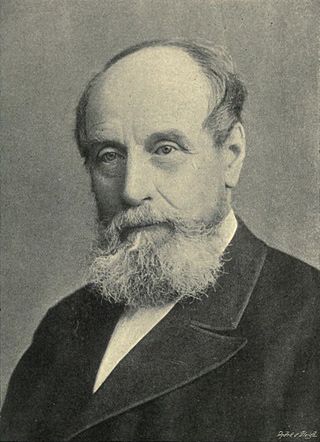
The Canadian Pacific Railway, also known simply as CPR or Canadian Pacific and formerly as CP Rail (1968–1996), is a Canadian Class I railway incorporated in 1881. The railway is owned by Canadian Pacific Kansas City Limited, known until 2023 as Canadian Pacific Railway Limited, which began operations as legal owner in a corporate restructuring in 2001.

Sir John Alexander Macdonald was the first prime minister of Canada, serving from 1867 to 1873 and from 1878 until his death in 1891. He was the dominant figure of Canadian Confederation, and had a political career that spanned almost half a century.

New France was the territory colonized by France in North America, beginning with the exploration of the Gulf of Saint Lawrence by Jacques Cartier in 1534 and ending with the cession of New France to Great Britain and Spain in 1763 under the Treaty of Paris.

Quebec nationalism or Québécois nationalism is a feeling and a political doctrine that prioritizes cultural belonging to, the defence of the interests of, and the recognition of the political legitimacy of the Québécois nation, particularly its French Canadian population. It has been a movement and a central issue in Quebec politics since the beginning of the 19th century. Québécois nationalism has seen several political, ideological and partisan variations and incarnations over the years.

Fort William was a city in Ontario, Canada, located on the Kaministiquia River, at its entrance to Lake Superior. It amalgamated with Port Arthur and the townships of Neebing and McIntyre to form the city of Thunder Bay in January 1970. Since then, it has been the largest city in Northwestern Ontario. The city's Latin motto was A posse ad esse, featured on its coat of arms designed in 1900 by town officials, "On one side of the shield stands an Indian dressed in the paint and feathers of the early days; on the other side is a French voyageur; the cent[re] contains a grain elevator, a steamship and a locomotive, while the beaver surmounts the whole."
Port Arthur was a city in Northern Ontario, Canada, located on Lake Superior. In January 1970, it amalgamated with Fort William and the townships of Neebing and McIntyre to form the city of Thunder Bay.
James Rodney Winter Sykes is a Canadian politician from Alberta. He served as the 30th Mayor of Calgary from 1969 to 1977 and as leader of the Alberta Social Credit Party from 1980 to 1982. He ran as a Liberal candidate in the 1984 federal election.

Thomas Sterry Hunt was an American geologist and chemist.

George Stephen, 1st Baron Mount Stephen,, known as Sir George Stephen, Bt, between 1886 and 1891, was a Canadian businessman. Originally from Scotland, he made his fame in Montreal and was the first Canadian to be elevated to the Peerage of the United Kingdom. He was the financial genius behind the creation of the Canadian Pacific Railway.

The International Railway of Maine was a historic railroad constructed by the Canadian Pacific Railway (CPR) between Lac-Mégantic, Quebec, and Mattawamkeag, Maine, closing a key gap in the railway's transcontinental main line to the port of Saint John, New Brunswick.

Thomas George Shaughnessy, 1st Baron Shaughnessy, was an American-Canadian railway administrator who rose from modest beginnings as a clerk and bookkeeper for the Milwaukee and St. Paul Railroad to become the president of the Canadian Pacific Railway, serving in that capacity from 1899 to 1918. In recognition of his stewardship of the CPR and its contributions to the war effort during the Great War, Shaughnessy was elevated to the Peerage of the United Kingdom on 1 January 1916 as Baron Shaughnessy, of the City of Montreal in the Dominion of Canada and of Ashford in the County of Limerick.

Richard Bladworth Angus was a Scottish-Canadian banker, financier, and philanthropist. He was a co-founder and vice-president of the Canadian Pacific Railway, president of the Bank of Montreal, president of the Royal Victoria Hospital, Montreal, president of the Montreal Art Association, and co-founder and president of the Mount Royal Club. He was the natural successor to Lord Mount Stephen as president of the Canadian Pacific Railway in 1888, but he did not desire the position; he twice refused a knighthood. The CPR Angus Shops were named for him, as was one of the later CP Ships.

Norris Roy ("Buck") Crump, was a Canadian businessman, who was chairman and president of the Canadian Pacific Railway (CPR). He was primarily responsible for converting the railroad to diesel locomotives, and expanded the company into non-transportation sectors.

Windsor Station is a former railway station in Montreal, Quebec, Canada. It used to be the city's Canadian Pacific Railway (CPR) station, and served as the headquarters of CPR from 1889 to 1996. It is bordered by Avenue des Canadiens-de-Montréal to the north, Peel Street to the east, Saint Antoine Street to the south and the Bell Centre to the west.

Sir John William Dawson (1820–1899) was a Canadian geologist and university administrator.

D'Alton Corry Coleman was a Canadian railway executive and businessman. He began working for the Canadian Pacific Railway (CPR) in 1899, and was promoted through its ranks until serving as president from 1942 to 1947. He oversaw expansion which added 3,620 kilometres (2,250 mi) of branch lines in the Canadian Prairies, and guided Western Canada railways through the Great Depression. He developed the CPR to support logistics during World War II, including manufacture of munitions, expanded shipbuilding and established one of the country's first private blood donation clinics. Canadian Pacific Air Lines was established under his leadership, and he became chairman of the Canadian Pacific Steamship Company, Canadian Pacific Hotels and other subsidiaries. He maintained good relations between the CPR and its unionized workers and believed in promoting from within the company.
The Composers, Authors and Publishers Association of Canada was a Canadian copyright collective for the right to communicate with the public and publicly perform musical works. CAPAC administered these rights on behalf of its members and those of affiliated international organizations by licensing the use of their music in Canada. Royalties were paid to the music creators after administration costs were deducted to pay for the operation of CAPAC.
Walter Reginald Baker was known for his work with various railway companies in Canada. Born in York, England, he worked seven years with the Allan Steam Ship Company in Montreal (1865-1872). The Montreal Historical Society reports that he followed this with three years as Aide-de-Campe for the Earl of Dufferin, Governor General of Canada (1873-1876), but a March 1902 edition of The Railway and Shipping World indicates that he entered service as a freight and passenger agent for Canada Central Railway in 1873. Subsequently, he held a series of positions with that company:

John Arthur Fraser was an English artist, photography entrepreneur and teacher. He undertook various paintings for the Canadian Pacific Railway. He is known for his highly realistic landscapes of Canada and the United States, many of them watercolor paintings.

Photographs have been taken in the area now known as Canada since 1839, by both amateurs and professionals. In the 19th century, commercial photography focussed on portraiture. But professional photographers were also involved in political and anthropological projects: they were brought along on expeditions to Western Canada and were engaged to document Indigenous peoples in Canada by government agencies.
















